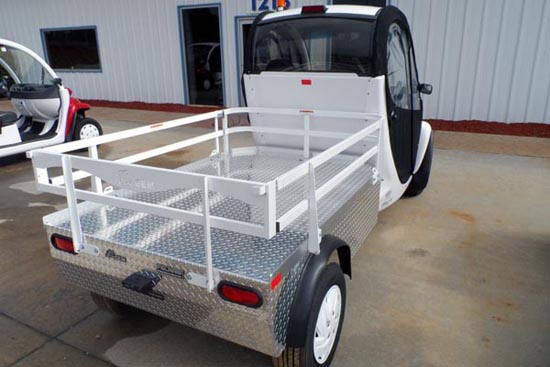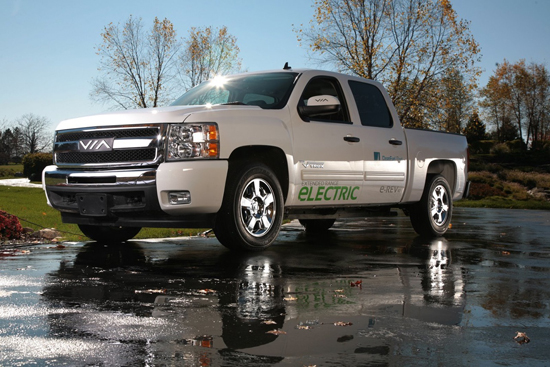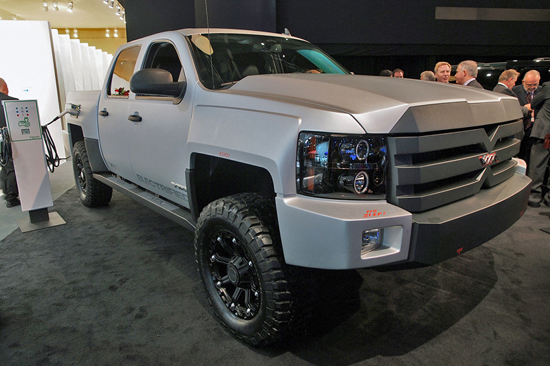Electric MiniTrucks Send F-250s to Garage – The Future
Tim Esterdahl | Feb 26, 2014 | Comments 14
For years, automakers have been trying to build an “electric truck” that actually makes sense. Most times, these electric trucks fall well short on towing and power needs of most consumers. Yet, is there a future for small electric trucks? Most likely and this is it.

These electric minitrucks sent the F-250s to the garage for most of the year.
In Lucas County, Ohio, they have parked their Ford F-250s and relegated them to snow removal. They are now using electric mini-trucks. Why? It saves them a boat load of money.
Doug Podiak, the facilities director for Lucas County, said they bought three 2006 GEM E2 Long Bed trucks as part of a pilot program. The total cost for all three was $21,000 and he estimates they save the county $7,000 annually in fuel and maintenance costs.
Why the switch? Podiak took a hard look at what his employees were using the fleet trucks for. In many instances, it was simply to move his 20 employees around town to maintain 12 public buildings. The street-legal electric trucks can carry up to 800 pounds which is enough to shuttle the staff and their supplies. So, instead of firing up the F-250s and using a very small percentage of their capability, he has the electric trucks.
These electric trucks are fairly cheap to buy and pay for themselves. While companies like VIA motors are trying to modify a Silverado 1500, it seems much more efficient to go with this solution. For the record, the VIA motors truck is a plug-in hybrid electric vehicle.
You probably remember VIA motors if you read this site regularly. They are working on developing the Silverado 1500 like electric truck. Recently, they announced they will have some inventory ready for commercial companies at a price of $79,000 each.

VIA Motors says this is the future of electric trucks. Yet at $79,000 a piece, it is a pretty big investment.
They also developed the XTRUX that puts out 800HP with 4WD.

The XTRUX is really impressive actually, except it isn’t really that practical. Who needs 800HP when off-roading?
What do you think? Is this the future of electric trucks or do you think a VIA motors like vehicle is still the way to go?
Related Posts:
Filed Under: Auto News


There is no doubt that electricity will be the main transportation fuel in the future. Last year there were almost 100,000 electric or extended range electric vehicles sold in the US. As recently as 2010, that number was less than 1000. Why has this number increased 100 times in the last 4 years? The reason is economics. While EVs and EREVs cost more to purchase, they are cheaper to own over the life of the vehicle. As battery technology and range improves, and the initial purchase price of these vehicles decreases, the cost to own will be reduced even further. In just the past 4 years, the MSRP of the Chevy Volt and the Nissan Leaf has been reduced almost 20%. This trend will continue as the production of these vehicles is scaled up, and the prices of batteries and other components are reduced.
Great points.
While there is a place for these mini trucks for short haul light use, kind of like the electric golf cart or a factory fort lift, I have my doubts people will be getting rid of their leather seat Tundras. Day after day I read about more powerful gas engines and now matter what the engines put out, it’s never enough.
My 5.9 diesel puts out 600 foot/lb and that engine has been left behind for Cummins 6.7. The F250 power stroke is even bigger.
So how many of you Tundra owners will be moving to an electric mini truck.
Much ado about absolutely nothing.
Larry,
My thoughts were more about electric vehicle usage in smaller fleets like the story above. I, personally, think this is will be part of the mix and give more credibility to EVs for some.
-Tim
These are clearly not a competitor to the conventional pickup truck as we know it, but there probably is a segment of the market that could use them for local stuff.
I’m sure that once they start to become a bit more popular the EPA and CARB will find some way to get their fingers into it (EMI emissions or something) and screw it all up also.
I understand what you are saying and battery powered electric materials handling machines have been around a long time. I can even see that in some municipal applications, people are wastefully using an F250 when something else will do the job more economically. When I worked for the state our motor pool had several Toyota Prius cars and for going across town for meetings they were a smart choice.
In addition when those lead acid batteries are shot, we ship the to Mexico to be smelted down. Not our problem.
Light rail in Salt Lake is electric overhead power and it does it’s job. Most of us driving around town can’t pull power from overhead wires so it’s niche solution. Batteries will never run a public bus system.
There is a building public mind set that these electric things are the way of the future and they are not keeping the idea in the context of what they can really do. No battery powered system will every replace a GE diesel locomotive engine ever! I have a friend who once said the National Park Service should start requiring guide companies to run electric motors on the big 25 person rafts. When I told him you would need a barge worth of batteries to make the 225 mile run to Diamond Creek he did not believe me.
There is a place for battery powered devices but, it won’t make a dent in our total demand for road transportation and rail freight transport.
People have also told me I should move out of my mountain home and move to Salt Lake and then I could live with an electric or hybrid car. My reply is good luck making that happen.
[…] For years, automakers have been trying to build an “electric truck” that actually makes sense. Most times, these electric trucks fall well short on towing and power needs of most consumers. Yet, is there a future for small electric trucks? Most likely and this is it. Pinboard (MacAaron) […]
800 hp on an electric truck wow. Electric vehicles can’t get here soon enough.
I wonder how long it will be before these things have to meet IIHS crash test standards. I doubt that those cloth doors will pass.
Of course motorcycles don’t comply either so it must be there is a loophole somewhere that these fit through.
Mendonsy,
Good point. No way these pass any crash tests. I wonder what the loophole is.
-Tim
Yeah!
It’s only a matter of time until some duly appointed public employee gets hit by a soccer mom driving a big SUV.
When that happens these cost savings of driving golf carts on a public highway will disappear fast.
A hybrid system similar to a locomotive would definitely work for large trucks but it would be costly. I could see a hybrid system similar to a locomotive as well in a pickup but the real challenge will be to reduce the battery size, increase the range, and lower the cost. I do not think straight electric would work because of the limited range and extreme weather conditions. Electric motors are much simpler and require less maintenance but having a smaller motor to recharge the batteries seems to make more sense.
I too think a motor generator setup could work. As you say, the cost would be very high and I doubt the consumer would be willing to live with the limits on how they work. Slow acceleration, very heavy etc. In order for a diesel to be efficient, it needs to run at 1 speed. Add turbo boost to get more fuel into the systems as needed but it still runs at one speed. Diesel just burns slower then gas. People are used to engines which redline ate 5500 RPM. My truck only operates between 1 and 3 k. It won’t get up and go for a high speed pass on the highway. The Tesla is a light car, how much current would it take and how big would the motor need to be to deal with a truck towing 10,000 pounds.
Anything with batteries will be confined to city cars are toy sports cars for big spenders. An battery powered truck won’t haul the boat at 75 MPH 200 miles for a weekend of boating.
Lucas County, Ohio has found it can park its more expensive-to-operated F250s, which have been relegated to snowplow duty.